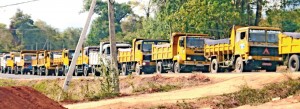News
EIA clears sand mining in north in spite of flagging environmental drawbacks
- Insists issues can be mitigated “without causing irreparable damages”
- EIA carried out by GSMB Technical Services (Pvt) Ltd, a subsidiary company of the Geological Survey and Mines Bureau, the industry regulator
Just weeks after an environmental impact assessment (EIA) backed the mining of heavy mineral sands in a three-kilometre stretch on the Akkaraipattu to Komari coast in Ampara, another study has cleared the harvesting of sands from a 6.5km section between Kokilai and Kokkuthoduvai in Mullaitivu.
The Government-owned Lanka Mineral Sands Ltd (LMSL) project is estimated to cost just Rs 500mn and also envisages the setting up of a processing plant at Karunaddukerny, north of Kokilai. The main minerals to be extracted are hi-titanium ilmenite, ilmenite, zircon, monazite, rutile and garnet. The mine life will be around 25 years.

File pic of a large scale sand mining operation
The EIA was carried out by GSMB Technical Services (Pvt) Ltd, a subsidiary company of the Geological Survey and Mines Bureau which is also the industry regulator. It flags several significant environmental drawbacks. But it insists the project “will not create significant negative impacts to the geological, ecological, coastal, hydrological and human environment” and the effects can be mitigated “without causing irreparable damages”.
An analysis has shown that the average percentage of mineral sands within the coastal stretch from Kokilai to Kokkuthoduvai is about 20 percent. The primary concentration plants (PCP) and mineral separation plant (MSP) will be in Kokkilai village.
Mined areas will be rehabilitated from sand that is left over (80 percent) after mineral extraction, the EIA report states. An additional 20 percent will have to be laid in the mined areas from a burrow site.
As the project area is a low-elevated coastal plain, coastal mining would increase the frequency of vulnerability to flooding, tropical storms, cyclones and, in the worst-case, tsunami, the report warns. Mined cells will be refilled with “white sand” which is less heavy than “black sand” and it could easily wash away during monsoons.
“When there is not enough sand due to the sea dynamic, the sea takes up the existing sand–whatever is on the beach,” it states. “As the beach migrates landwards, they draw upon the land and landward dunes for a constant supply of sand, as it does from the shore. Wind, waves and currents easily move the unconsolidated sand in the coastal area. Mining is particularly senseless in a time of rising sea level when sand is sorely needed as a storm energy buffer.”
Wells will be constructed more than five kilometres inland from the mining site to obtain fresh groundwater to remove chloride from the mineral sand, the EIA report states. Mining in the tidal and beach zones will be manual, with the use of shovels, while mining in the berm zone (beach terrace formed in the backshore) will be with front-end loaders.
There are 12 drag net or “ma del” fishing locations in the proposed project area. But a majority of communities in the vicinity were unaware of the initiative. Fishermen, in particular, had “no clear idea” about its impacts with 68 percent of inhabitants fearing fishing will be disturbed.
Sand mining and separation activities will affect water quality in the shallow sea, the EIA says. Beach erosion and land run-off will increase suspended solids in near-shore waters, harming organisms owing to reduced light penetration. This will cut primary production and feeding opportunities. There could also be an impact on the Kokilai lagood system and its productivity.
“Decline of marine ecosystem services would reduce fish catch, which means economic losses for the local fishermen, causing problems for people who rely on fishing for their livelihoods,” it adds. “Applying sound mitigation measures during operation can minimize, prevent or correct this environment impact.”


